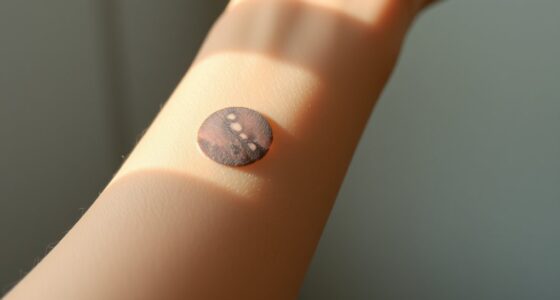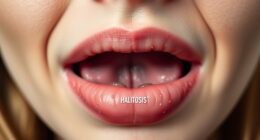Home sleep tests let you monitor your breathing, oxygen levels, and sleep patterns from your bed without visiting a clinic. You use easy-to-wear devices that track airflow, oxygen saturation, and heart rate overnight. These tests are convenient, affordable, and provide quick results to help identify sleep apnea early. If symptoms suggest sleep issues, a home test can be a good first step. Keep going to discover how these tests work and what to expect.
Key Takeaways
- Home sleep tests monitor breathing, oxygen, and heart rate overnight to detect sleep apnea outside clinical settings.
- Devices are user-friendly, attach sensors to measure airflow, breathing effort, oxygen saturation, and movement.
- Results include metrics like the Apnea-Hypopnea Index (AHI) to determine sleep apnea severity.
- Home tests offer a convenient, cost-effective alternative to in-lab sleep studies, suitable for mild symptoms.
- Limitations include less detailed data and potential errors from self-administration, requiring professional follow-up if needed.
How Do Home Sleep Tests Work?

Home sleep tests work by allowing you to monitor your sleep patterns and breathing from the comfort of your own bed. You set up the device before you go to sleep, attaching sensors to your body as instructed. These sensors track essential signs like airflow, breathing effort, oxygen levels, and heart rate throughout the night. The device records this data without requiring you to visit a sleep lab. As you sleep, it continuously gathers information, capturing any irregularities or pauses in breathing. When morning comes, you simply remove the sensors and send the device to a lab or a healthcare provider. They analyze the recorded data to identify potential signs of sleep apnea or other sleep disorders, all without disrupting your usual sleep routine. Understanding air quality monitoring can help improve your sleep environment and overall health.
Types of Devices Used in Home Testing

Various devices are designed to monitor your sleep and breathing during home tests, offering different features to suit your needs. The most common device is the portable sleep monitor, which records airflow, breathing patterns, oxygen levels, and heart rate. These devices typically include a nasal cannula or thermistor to track airflow, along with pulse oximeters to measure blood oxygen. Some systems also incorporate chest or abdominal bands to detect respiratory effort. Modern devices are compact, easy to wear, and user-friendly, allowing you to sleep naturally at home. They often connect wirelessly to smartphones or tablets, transmitting data for analysis. The variety of devices ensures you can choose one that fits your comfort level, making home testing a practical alternative to lab-based sleep studies. Additionally, understanding sleep apnea detection methods can help you better interpret your results and discuss treatment options with your healthcare provider.
Preparing for Your Home Sleep Study

Preparing for your home sleep study involves taking simple steps to guarantee accurate results and a comfortable experience. First, follow any specific instructions your healthcare provider gives you, such as avoiding caffeine or certain medications before the test. Make sure your sleep environment is quiet, dark, and comfortable to promote natural sleep. Lay out your pajamas and any items you’ll need, like your ID or insurance information, nearby. Remove any heavy lotions or oils from your face, as these can interfere with sensors. Keep your hair clean and dry, especially if you’ll be wearing sensors on your scalp or face. Additionally, choosing a suitable sleep environment aligns with environmental considerations to ensure a restful night. Finally, plan to get a full night’s sleep beforehand to help assure your test is as realistic and effective as possible.
What to Expect During the Testing Process

When your sleep test begins, you’ll first prepare by following simple setup instructions. Then, you’ll attach monitoring devices that track your breathing and other key signals throughout the night. As you sleep, the devices will record your data, which is later analyzed to detect any signs of sleep apnea. Proper placement and calibration of the sensors are essential for accurate diagnostic results.
Preparing for the Test
Before your sleep study begins, you’ll receive specific instructions on how to prepare. Follow these carefully to guarantee accurate results. You might be asked to avoid caffeine, alcohol, and heavy meals before bed. Wear comfortable, loose-fitting clothing and avoid using lotions or oils on your face, as these can interfere with sensors. Prepare your sleeping environment by making sure your bedroom is quiet, dark, and at a comfortable temperature. Keep a list of any medications you take, as your healthcare provider may advise you to adjust your routine. Make sure your phone or alarm is set if needed. Most importantly, relax and approach the test as a normal night’s sleep; your goal is to sleep naturally so the monitor can gather accurate data. Incorporating automation in healthcare can also assist in ensuring all procedures are followed properly and data is accurately recorded.
Attaching Monitoring Devices
What can you expect when the monitoring devices are attached? Once the technician secures the sensors, you’ll feel some adjustments but shouldn’t experience discomfort. These devices measure your breathing, oxygen levels, heart rate, and movement throughout the night. The setup is quick, typically taking about 15-30 minutes. Here’s what’s involved:
| Device | Purpose |
|---|---|
| Nasal cannula | Tracks airflow and breathing pauses |
| Chest/abdominal bands | Measures chest movement and effort |
| Pulse oximeter | Monitors oxygen saturation |
| Sensors on limbs | Detect movement and limb activity |
| Data recorder | Stores all collected information |
Expect to wear these devices comfortably, and remember, they’re designed to stay secure all night. Additionally, understanding how these monitoring devices work can help ease any concerns about the testing process.
Monitoring Overnight Results
As your monitoring session begins, the devices will start collecting data on your breathing, oxygen levels, heart rate, and movements throughout the night. You might notice some sensors attached to your body, but they shouldn’t cause discomfort. Here’s what to expect during the process:
- Continuous recording of your breathing patterns and airflow.
- Monitoring of oxygen saturation levels in your blood.
- Tracking of your heart rate and rhythm.
- Observation of body movements and position changes.
- The collected data can be analyzed using data analytics to identify potential sleep disturbances and patterns.
You may be asked to stay still and avoid removing any sensors. Some devices record data passively, while others may require brief interactions. Rest assured, the process is straightforward, and the goal is to gather accurate information for your sleep apnea assessment.
Interpreting Results From Home Sleep Tests

Interpreting results from home sleep tests can seem complicated at first, but understanding what the numbers mean is essential for evaluating your sleep health. Your report typically includes metrics like the Apnea-Hypopnea Index (AHI), which shows how many breathing interruptions you experience per hour. An AHI above 5 suggests mild sleep apnea, while higher scores indicate moderate or severe cases. You’ll also see data on oxygen levels, indicating if your blood oxygen drops during sleep. Keep in mind, occasional events are normal, but frequent interruptions point to a problem. Review your results carefully, and if they indicate sleep apnea, consult a healthcare professional for a detailed assessment and personalized treatment plan. Accurate interpretation helps you understand your condition and take the right steps forward. Additionally, understanding air quality factors can help improve your overall sleep environment and health.
Benefits of Using Home Tests for Sleep Apnea Detection

Using home tests for sleep apnea makes screening more convenient and accessible, so you can get tested without leaving your house. They often cost less than lab-based studies, making it easier to prioritize your health. These benefits encourage more people to identify sleep issues early and seek treatment. Additionally, understanding Forsale 100 options can help you find affordable testing solutions.
Convenience and Accessibility
Have you ever wondered how easy it is to check for sleep apnea without visiting a clinic? Home tests make it simple and accessible. You can:
- Sleep comfortably in your own bed instead of a clinical setting.
- Avoid long wait times for appointments and results.
- Use user-friendly devices designed for quick setup.
- Conduct tests anytime that fits your schedule, even overnight.
- Plus, these tests often include diagnostic accuracy to ensure reliable results.
This convenience means you don’t have to disrupt your daily life or travel to a specialist. It’s a straightforward way to monitor your sleep health without the hassle of traditional methods. With home tests, you get quick, accessible insights right from your own bedroom, making sleep apnea detection less intimidating and more manageable.
Cost-Effective Screening
Home sleep apnea tests offer a cost-effective way to identify potential issues without the high expenses associated with in-clinic evaluations. These tests are generally affordable, saving you money while providing reliable results. They eliminate costs like sleep lab fees, transportation, and time off work. Plus, you can test in the comfort of your own home, which may lead to earlier detection and treatment. To highlight the affordability, consider this comparison:
| In-Clinic Test | Home Sleep Test |
|---|---|
| Higher cost | Lower cost |
| Longer process | Quick setup |
| Potential inconvenience | Convenient and accessible |
Limitations and Considerations of At-Home Testing

While at-home sleep apnea testing offers convenience and accessibility, it does have notable limitations that you should consider. First, these tests may not capture complex cases or differentiate between types of sleep disorders. Second, they rely heavily on self-administration, which can lead to errors or incomplete data. Third, they don’t provide detailed information about your sleep stages or oxygen levels throughout the night. Fourth, certain health conditions, like severe obesity or other medical issues, might require more extensive in-lab evaluations. Keep in mind that at-home tests are generally less accurate for diagnosing more complicated or severe cases. While they’re useful for initial screening, they shouldn’t replace professional medical assessments when symptoms persist or worsen.
Who Should Consider a Home Sleep Test?

If you have mild sleep symptoms or are concerned about risk factors like obesity, a home sleep test might be a good option for you. Age and existing sleep issues can also make testing at home more suitable than a sleep clinic. Understanding your specific situation helps determine if a home test can provide the answers you need.
Mild Sleep Symptoms
Even mild sleep symptoms can indicate the presence of sleep apnea, which is worth investigating. If you notice subtle signs, consider a home sleep test. These symptoms might include:
- Occasional snoring, especially if it disrupts your partner’s sleep
- Daytime fatigue or feeling unusually tired
- Morning headaches or dry mouth
- Difficulty concentrating or mood changes
Even if symptoms seem minor, they can affect your quality of life and health. A home sleep test is a simple, accessible way to determine if sleep apnea is the cause. Early detection helps you seek treatment before more serious issues develop. If these signs sound familiar, don’t wait—consider discussing a home sleep test with your healthcare provider.
Obesity and Risk Factors
Obesity markedly increases the risk of sleep apnea, making it an important factor to evaluate when appraising your sleep health. Excess weight, especially around your neck, can obstruct your airway, leading to breathing pauses during sleep. If you’re overweight or obese, your chances of developing sleep apnea rise significantly, even if you don’t experience obvious symptoms. You should consider a home sleep test if you have a high body mass index (BMI), loud snoring, or daytime fatigue. Other risk factors include neck circumference and waist size. Identifying sleep apnea early can improve your quality of life and reduce related health risks like hypertension and heart disease. If obesity is a concern, discussing your symptoms with a healthcare provider and exploring testing options is a wise step.
Age and Sleep Issues
As you age, the risk of developing sleep apnea increases, making it important to recognize when a home sleep test might be necessary. Older adults often experience sleep issues due to changes in muscle tone, health conditions, or lifestyle factors. Consider a home test if you notice:
- Loud, persistent snoring
- Gasping or choking during sleep
- Excess daytime fatigue
- Restless sleep or frequent awakenings
These signs suggest disrupted breathing patterns that may indicate sleep apnea. Even if you don’t fit the typical profile, age-related changes can still elevate your risk. Early detection helps improve sleep quality and overall health. If you experience these symptoms, talking to your healthcare provider about a home sleep test is a wise step.
Next Steps After a Positive Sleep Apnea Result

Once your sleep study confirms you have sleep apnea, the next step is to consult with a healthcare professional to discuss treatment options. This is a pivotal moment—you’re taking control of your health. Treatment can improve your sleep quality, boost your energy, and reduce health risks. To help you understand what’s ahead, here’s a glimpse of possible outcomes:
| Feeling Rested | Improved Energy | Better Focus |
|---|---|---|
| Restful nights | Wake up refreshed | Clearer thinking |
| Less daytime drowsiness | More productivity | Enhanced mood |
| Reduced health risks | Better quality of life | Greater safety |
Comparing Home Tests and Sleep Clinic Assessments

After receiving a positive sleep apnea diagnosis, you’ll need to choose how to proceed with testing. Home tests and sleep clinic assessments each have pros and cons. Here’s what to take into account:
- Convenience: Home tests are simple to do in your own bed, while clinics require scheduling and overnight stays.
- Accuracy: Sleep clinics provide extensive data, including brain activity, while home tests mainly measure breathing and oxygen levels.
- Cost: Home tests are typically less expensive, but insurance coverage varies.
- Expert Oversight: Clinics offer professional interpretation and immediate support, whereas home tests rely on self-analysis and follow-up visits.
Deciding depends on your symptoms, budget, and comfort level, but understanding these differences helps you make an informed choice.
Frequently Asked Questions
How Accurate Are Home Sleep Tests Compared to Clinical Evaluations?
You might wonder how accurate home sleep tests are compared to clinical evaluations. While home tests are convenient and often effective for detecting sleep apnea, they may not be as thorough as in-lab sleep studies. Factors like device quality and proper setup influence accuracy. However, for many, home tests provide reliable results, especially for initial screenings, helping you decide if further medical assessment is needed.
Can I Use a Home Sleep Test if I Have Other Health Conditions?
If you have other health conditions, you can often still use a home sleep test, but it’s crucial to consult your doctor first. They can determine if a home test is suitable or if you need a more detailed clinical evaluation. Your health issues might affect the accuracy of the results, so professional guidance ensures you get the right diagnosis and treatment plan tailored to your specific needs.
Are There Age Restrictions for Using Home Sleep Testing Devices?
They say, “Age is just a number,” but when it comes to home sleep tests, age can matter. Usually, these devices are suitable for adults and sometimes older teens, but kids under 12 often need more detailed evaluations. You should check with your healthcare provider to determine if a home test is appropriate for your age. Remember, the goal is to get an accurate diagnosis safely and comfortably.
How Long Does It Take to Receive Results After the Test?
You wonder how long it takes to get your results after a sleep test. Typically, it takes about 1 to 2 weeks for your healthcare provider to analyze the data and send you the results. Factors like the clinic’s workload or lab processing times can slightly delay this. During this period, you might be contacted for further testing or to discuss treatment options, so stay patient and keep in touch with your provider.
What Should I Do if My Home Sleep Test Indicates Sleep Apnea?
Did you know that around 1 in 15 adults have sleep apnea but remain undiagnosed? If your home sleep test shows signs of sleep apnea, you should see a healthcare professional promptly. They can review your results, discuss treatment options, and may recommend a sleep specialist or CPAP therapy. Don’t ignore the findings—addressing sleep apnea improves your health and quality of life.
Conclusion
Now that you know how home sleep tests work and what to expect, you can take control of your sleep health. Remember, it’s better to nip potential issues in the bud rather than let them fester. While these tests are handy, they’re not a one-size-fits-all solution. Stay proactive, consult your healthcare provider, and don’t be afraid to explore all options—sometimes, the early bird catches the worm in managing sleep apnea effectively.








